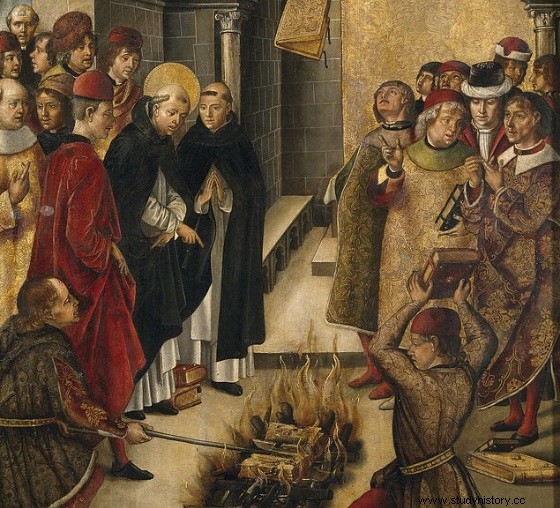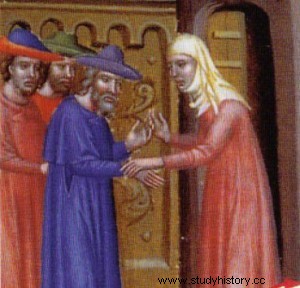 In the Middle Ages, the Cathars , who are also referred to as Albigensians, belonged to a Manichaean Christian movement widespread in the south-west of France. The birth of Catharism or Catharisms is probably in the middle of the 12th century, at the time when the pope placed his authority at the head of all other power. Considering themselves the successors of the apostles, the Cathars set up their own model of Church, with its hierarchy and its sacraments. The Roman Church then launched into a fight against these protesters whom it considered and condemned as heretics.
In the Middle Ages, the Cathars , who are also referred to as Albigensians, belonged to a Manichaean Christian movement widespread in the south-west of France. The birth of Catharism or Catharisms is probably in the middle of the 12th century, at the time when the pope placed his authority at the head of all other power. Considering themselves the successors of the apostles, the Cathars set up their own model of Church, with its hierarchy and its sacraments. The Roman Church then launched into a fight against these protesters whom it considered and condemned as heretics.
The origins of Catharism
The medieval dissidents known especially since the 19th century as the Cathars were not representatives of a resurgence of ancient Manichaeism that arose in the West through various Eastern sects - that of the bogomiles being presented as the last filiation. The opinion, going back to the Catholic clerics - detractors of the Cathars in medieval times -, has a tough skin, the dissidents themselves having however never claimed an Eastern filiation. It is possible to situate the birth of the Catharisms around the middle of the 12th century, in the context of the post-“Gregorian reform” carried out by the papacy for almost a century and in reaction to the new order of the world and of Christian society that it intends to impose the day after the said reform.
Strengthened by his victory over the laity in the fight which had opposed them (papaty/empire) during the reform, the pope placed himself at the head of the new militant Church, and by extension of society as a whole. The "society of persecution" - expression of the English medievalist Robert Moore - is therefore in motion. Determined to fight and eradicate the opponents of this theocratic model, who will in future be called "heretics", the builders of the new order, through their representatives in the fight against heresy - Cistercians and Premonstratensians - launch into the prosecution of the protesters.
Spotted under different names according to the regions of the medieval West:weavers, Cathars, publicans, buggers in Flanders, Rhineland and Burgundy, patarins in Italy and Albigensians in the South of the France, they called themselves simply good men and good women in the South of France or Christians and Christians in Italy.
The Cathars criticize the excesses of the Catholic Church
The origin of the criticism leveled against the Catholic Church by these Christians and/or good men is found in the context of the social, political, economic, religious and cultural transformations that are shaking the Christian West between the 10th and 12th centuries, some dating back even further, to the Carolingian period (9th century). Like other groups condemned as “heretics” in previous centuries (Donatists, then Gregorian reformers), the Cathars condemn the enrichment of the Roman Church as well as the depraved morality of its prelates, the cause of their unworthiness. Dating back to the time of Pope Sylvester I (314-335) - considered the Antichrist - the indignity of the Catholic lineage rendered the sacraments conferred by its prelates ineffective.
 For this reason, and until the disappearance of the last followers in the pyres of the inquisition in the first years of the fourteenth century, the good men considered themselves the true successors of the apostles, tracing their lineage to the Church from early Christian times. Moral reasons are therefore at the origin of the criticism and protest that these dissidents express towards the Catholic hierarchy, proposing for their part a return to the model of the Church of apostolic times.
For this reason, and until the disappearance of the last followers in the pyres of the inquisition in the first years of the fourteenth century, the good men considered themselves the true successors of the apostles, tracing their lineage to the Church from early Christian times. Moral reasons are therefore at the origin of the criticism and protest that these dissidents express towards the Catholic hierarchy, proposing for their part a return to the model of the Church of apostolic times.
However, we are dealing with a very medieval Christian Church, as evidenced by their criticism of the Catholic sacraments. Strongly imbued with the monastic spirituality dominating the high Middle Ages, the Cathars (from the Greek katharos, “pure”) of the Rhineland, like the good men of the South of France, continued to take a very negative view of this world, the temporal power and the urges of the flesh, considered diabolical in nature. Like the monks of previous centuries, our dissidents base their negative vision of the world on the reading of certain passages from the New Testament, and more precisely from the Gospel of John, the Apocalypse and the Epistles of Paul, collected and commented on by the Languedoc dissident author of an “anonymous treatise”.
Opposition to Catholic sacraments
In this treatise, he defends the existence of two worlds, one good and the other bad. Radicalizing the belief in the duality of worlds, he affirms that God is at the origin of the celestial world, of eternal creation, while the Devil, the foreign god, also called in the Scriptures "god of this world" or "prince of this world”, is at the origin of the visible world, of nothingness. For good men, the Devil (Lucifer, angel of light) is responsible for sin at the origins, when in wanting to measure himself against the Father he sins with pride. Expelled by the Father, the Devil then makes the world as well as the bodies of flesh, or "coats of skin", of which Genesis speaks (chapter 3, verse 21).
At the beginning of the 13th century, certain Cathar churches, especially in Italy, divided among themselves and sometimes clashed over essential questions, such as the origin of evil, sin, free will, divine omnipotence or the incarnation of the Son of God.
The Principle of Good and Evil
It was then that one of these Italian Cathar Churches, that of Desenzano, near Lake Garda, formulated the belief in a dualism of opposing principles, a principle of Good and a principle of Evil, respectively responsible for good and invisible and bad and corruptible creation. A theological treatise on the two principles was drawn up by one of the masters of this Church, Jean de Lugio, around 1230-1240. Although Catholic theologians have always accused the Cathars of dualism, this belief was neither original nor majority among the dissidents - penetrating late in the Pays d'Oc - it was one of the results of the process of rationalization of Christianity in which participated these medieval dissidents.
For them, the Catholic Church is the Church of the Devil and its doctrine “that of the demons”. Inspired by the organization of the first Christian Churches, good men, like the apostles, practiced the baptism of Christ by the laying on of hands, which they called consolation in Occitan.
However, unlike baptism in apostolic times, Cathar spiritual baptism symbolizes entry into religion, making a simple believer a Cathar religious, a good man.
Before receiving it, the future good man (perfect or perfect for the inquisition) must undergo a period of novitiate during which he will learn the precepts of morality and rule inspiration that he must observe (not to kill, not to commit adultery, not to lie, not to steal, not to swear, not to eat meat, eggs or dairy products, obligation to practice young weekly and annual, as well as prayers). Believers could also receive spiritual baptism before dying (consolation of the dying), provided they had previously requested it from the hierarchy of their church (pact or convenientia).
The organization of the Cathar Church
 It is from among good men (regular clergy) that the hierarchy (secular clergy) of this Church is elected . It is made up of three categories:bishops, deacons and elders and/or priories. Each church is headed by a bishop who manages it autonomously and independently of others, good men do not recognize a higher authority. The deacons, responsible for the communities of good men and good women within their diocese, are responsible for providing the Service, or aparelhament in Occitan, a monthly ceremony of confession.
It is from among good men (regular clergy) that the hierarchy (secular clergy) of this Church is elected . It is made up of three categories:bishops, deacons and elders and/or priories. Each church is headed by a bishop who manages it autonomously and independently of others, good men do not recognize a higher authority. The deacons, responsible for the communities of good men and good women within their diocese, are responsible for providing the Service, or aparelhament in Occitan, a monthly ceremony of confession.
Communities or houses of good men and/or good women are managed by elders (male communities) or priories (female communities). Because these “houses” (domihaereticomm) constituted, in the time preceding the crusade, the basic cells of the local communities. In the last third of the 12th century, the dissidence of good men was organized around three bishoprics, that of Albi, that of Toulouse and that of Carcassonne.
It was not until 1226 that the leaders of the Churches of Carcassonne and Toulouse created the Church of Razès in Pieusse, near Limoux; then around 1229 or 1232, the leaders of the Church of the good men of Toulouse created that of Agen. The two new dioceses probably result from the fractures caused within the communities by the effects of the crusade against the Albigensians (1209-1229). The beginnings of this war declared by the papacy against the princes of the South in 1208 sounded the death knell for what was a Christian Church of its time.
Bibliography
- History of the Cathars, by Michel Roquebert. Tempus, 2002.
- The Cathar religion, by Michel Roquebert. Tempus, 2009.
- The Catharisms:Dissident models of medieval Christianity (12th-13th centuries). PURE, 2009.
- Understanding the tragedy of the Cathars, by Claude Lebédel. Ouest-France editions, 2014.
